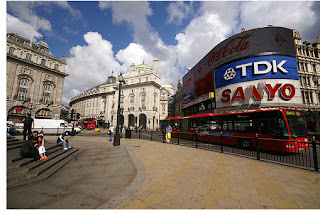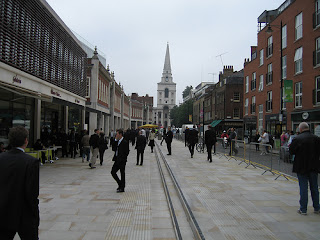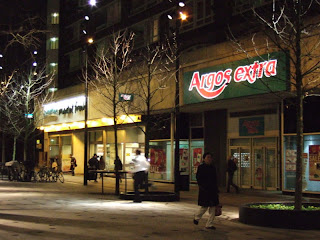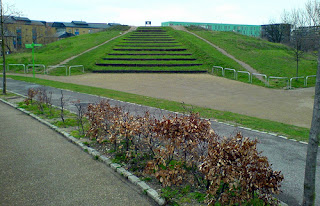| Scoping Study 5 - Paradise Park |
Thursday, 29 November 2007
Wednesday, 14 November 2007
A spatial scoping study 1: Seven Dials & Whitfield Gardens
Sample findings from an initial scoping study starting in Seven Dials and continuing up to Whitfield Gardens, off Tottenham Court Road.
It's interesting to note that the hub of Seven Dials is a roundabout that says 'yes'...
whilst the Whitfield Gardens has been designed to give it a sense of place, yet is missed by passers-by.
View details mapped
Labels:
Neal's Yard,
Seven Dials,
Whitfield Gardens
Tuesday, 30 October 2007
Secured by Design Principles: excerpt
source: http://www.securedbydesign.com/pdfs/SBD-principles.pdf
2 Environmental quality and sense of ownership
Poor environment: alienation and fear
2.1 A poor quality and sterile environment can create feelings of alienation amongst residents and other users, and result in an area where people feel uncomfortable, where pride and sense of shared ownership of the environment is low. .Few people will want to linger in public spaces where crime and disorder/or fear of crime is high. In the extreme, this might be the bleak inner city “concrete jungle” characterised by barbed wire and heavy duty security hardware on buildings, where broken glass and graffiti are commonplace. To varying degrees however, similar effects may be seen in other less severely degraded urban environments. Well-designed environment: community cohesion Secured by Design Principles 2004 version 1 ACPO CPI June 2004 6
2.2 In an environment which is well designed, attractive, clearly defined and well maintained people are likely to take pride in their surroundings, will tend to feel comfortable and safe and have a sense of shared ownership and responsibility.
2.3 A ‘well designed’ environment is one that fulfils all its intended functions in an effective and harmoniously co-ordinated manner.
2.4 An ‘attractive’ environment in this context means one which has evolved or has been successfully designed to meet the needs of its legitimate users, such as the need for safe convenient means of access, the need to enable social interaction, to cater for recreational needs, etc. Legitimate users (ie the responsible majority of the population) will naturally find the environment ‘attractive’ because it is responsive to their needs. The greater the attraction for legitimate users, the less will be the attraction for the criminal minority.
2.5 A ‘clearly defined’ environment means one in which there is no ambiguity as to which areas are private, which are public, and how the two relate to one another. There may be transitional zones of semi-public or semi-private space [often referred to as ‘buffer zones’], or there may be strong physical demarcation between public and private areas by means of a wall, fence or hedge. The critical point is that the environment should be capable of being easily ‘understood’ by those experiencing it.
Anonymity
2.6 Crime is always easier to commit where offenders cannot be recognised, so in consequence they will take opportunities to offend where they are likely to benefit from this anonymity. The built environment, including areas of open space, can be organised so that it either creates the potential for, or alternatively reduces the levels of anonymity. In busy public places strangers will naturally tend to be ignored, and offenders can take advantage of this anonymity, and therefore opportunity, to commit offences. This can lead to problems where public space directly abuts private space because it can allow potential offenders to come into close proximity with private property without being noticed. This problem can be addressed by changing the nature of the part of the public space nearest to the private land or property, by reorganising it so that residents/property owners are able to exercise a degree of control over it, in effect creating a buffer between the wider public space and the private space. This ‘buffer’ might or might not still be legally public space, but if it is reorganised or redesigned in such a way as to create a zone of more ‘defensible’ space, anonymity will be reduced and potential
offenders will correspondingly be discouraged.
2 Environmental quality and sense of ownership
Poor environment: alienation and fear
2.1 A poor quality and sterile environment can create feelings of alienation amongst residents and other users, and result in an area where people feel uncomfortable, where pride and sense of shared ownership of the environment is low. .Few people will want to linger in public spaces where crime and disorder/or fear of crime is high. In the extreme, this might be the bleak inner city “concrete jungle” characterised by barbed wire and heavy duty security hardware on buildings, where broken glass and graffiti are commonplace. To varying degrees however, similar effects may be seen in other less severely degraded urban environments. Well-designed environment: community cohesion Secured by Design Principles 2004 version 1 ACPO CPI June 2004 6
2.2 In an environment which is well designed, attractive, clearly defined and well maintained people are likely to take pride in their surroundings, will tend to feel comfortable and safe and have a sense of shared ownership and responsibility.
2.3 A ‘well designed’ environment is one that fulfils all its intended functions in an effective and harmoniously co-ordinated manner.
2.4 An ‘attractive’ environment in this context means one which has evolved or has been successfully designed to meet the needs of its legitimate users, such as the need for safe convenient means of access, the need to enable social interaction, to cater for recreational needs, etc. Legitimate users (ie the responsible majority of the population) will naturally find the environment ‘attractive’ because it is responsive to their needs. The greater the attraction for legitimate users, the less will be the attraction for the criminal minority.
2.5 A ‘clearly defined’ environment means one in which there is no ambiguity as to which areas are private, which are public, and how the two relate to one another. There may be transitional zones of semi-public or semi-private space [often referred to as ‘buffer zones’], or there may be strong physical demarcation between public and private areas by means of a wall, fence or hedge. The critical point is that the environment should be capable of being easily ‘understood’ by those experiencing it.
Anonymity
2.6 Crime is always easier to commit where offenders cannot be recognised, so in consequence they will take opportunities to offend where they are likely to benefit from this anonymity. The built environment, including areas of open space, can be organised so that it either creates the potential for, or alternatively reduces the levels of anonymity. In busy public places strangers will naturally tend to be ignored, and offenders can take advantage of this anonymity, and therefore opportunity, to commit offences. This can lead to problems where public space directly abuts private space because it can allow potential offenders to come into close proximity with private property without being noticed. This problem can be addressed by changing the nature of the part of the public space nearest to the private land or property, by reorganising it so that residents/property owners are able to exercise a degree of control over it, in effect creating a buffer between the wider public space and the private space. This ‘buffer’ might or might not still be legally public space, but if it is reorganised or redesigned in such a way as to create a zone of more ‘defensible’ space, anonymity will be reduced and potential
offenders will correspondingly be discouraged.
Friday, 26 October 2007
Tuesday, 23 October 2007
Signs of Life - part c - Whyte quote
“It is difficult to design a space that will not attract people - what is remarkable is how often this has been accomplished.” Today, many public spaces seem to be intentionally designed to be looked at but not touched. They are neat, clean, and empty - as if to say, “no people, no problem!” But to us, when a public space is empty, vandalized, or used chiefly by undesirables, this is generally an indication that something is very wrong with its design, or its management, or both." William H. Whyte
Haque
Environment XML
Environment XML enables people to tag and share remote realtime environmental data; if you are using Flash, Processing, Arduino, Director or any other application that parses XML then you can both respond to and contribute to environments and devices around the world.
Environment XML enables people to tag and share remote realtime environmental data; if you are using Flash, Processing, Arduino, Director or any other application that parses XML then you can both respond to and contribute to environments and devices around the world.
Signs of Life - part b
In terms of fear or security, it seems an environment covered by a heavy cctv presence can indicate a place with real problems in the human activity it commonly sees. Equally a very high wall or fence, or even inappropriately bright lighting. What kinds of life do we imagine in these places? What other examples can be found?
Signs of Life? part a
Speaking to a few people about this project, I have been getting feedback that one of the important characteristics people look for, or more importantly 'sense' for, when they encounter a new place is whether there are any signs of life, and if so what kinds of signs are those? They can be negative or positive, it seems.
Monday, 22 October 2007
Details: Richard Wentworth and Jane Sulton Furi



This 'Industrial Design Supersite' has a great article on Richard Wentworth (artist) and Jane Sulton Furi (founder of IDEO)
looking at http://www.core77.com/reactor/03.07_parallel.asp
Jane Sulton Furi has a whole site dedicated to the subtle ways in which people react to the world around them, including a collection of many people's images and stories. She categorises these seemingly 'thoughtless acts' as reacting, adapting, co-opting, etc. Ways we engage thoughtlessly. Fulton Suri has used these categories as an organizing principle, and believes such details reveal larger patterns and bigger insights.
http://www.thoughtlessacts.com/
Although their visual outcomes are not dissimilar, what's interesting is the artist's more serendipitous perspective on the world in comparison to the designers. Yet Wentworth also categorises: "It doesn't take very long to realize that some are warnings, some repairs, some reminders, some adjustments." As the author states "Where others may have simply seen a sandwich—if anything at all—Wentworth notices the details which fit his world view."
New Barking Town Square
Barking town square in construction



Barking and Dagenham council have embarked on an impressive regeneration programme, with a central focus on the town square. This was previously a wind swept, concrete-paved square that housed a carpark, and although adjacent to the library and town hall, was seldom populated. there was just no reason to be there.
The construction is nearing completion (if not there already), and could prove an interesting study site, as could be contrasted with the nearby station (which is downright nasty), and has made unusual use of details (colour, material etc) in a previously expansive space.


Barking and Dagenham council have embarked on an impressive regeneration programme, with a central focus on the town square. This was previously a wind swept, concrete-paved square that housed a carpark, and although adjacent to the library and town hall, was seldom populated. there was just no reason to be there.
The construction is nearing completion (if not there already), and could prove an interesting study site, as could be contrasted with the nearby station (which is downright nasty), and has made unusual use of details (colour, material etc) in a previously expansive space.
Labels:
barking,
in construction,
town square
Space-Genre-Categories
• Greenspaces
• Residential areas
• Retail/ Commercial areas
• Public transport interchanges
• Residential areas
• Retail/ Commercial areas
• Public transport interchanges
Labels:
categories,
genre,
space
Participant-User-Categories
• Tourists: little knowledge of a space, different cultural codes.
• Night-time users (shift-workers, revellers): knowledge of a space in time-based context.
• Commuters: limited knowledge of non-transport spaces that form transient parts of their journey.
• Residents / walkers: in-depth knowledge of a space and social make-up
• Night-time users (shift-workers, revellers): knowledge of a space in time-based context.
• Commuters: limited knowledge of non-transport spaces that form transient parts of their journey.
• Residents / walkers: in-depth knowledge of a space and social make-up
Labels:
categories,
participant,
user
Sunday, 21 October 2007
Documenting London : Nico Hogg
Nico Hogg is a great amateur photographer on Flickr who has documented many housing estates and public spaces in London. There are some very moving and downright scary photos on there, which makes you question how and why seeing a photo of a place in the comfort of your own home can make you feel uneasy.
http://www.flickr.com/photos/nicohogg/
http://www.flickr.com/photos/nicohogg/
Friday, 19 October 2007
Thursday, 18 October 2007
Wednesday, 17 October 2007
Emotional Cities
Charles Landry has written about we should plan our cities around emotions. This is effectively our argument, yet we dig down a bit deeper to aim to understand why our physical enviroment makes us feel a particular way. I found this quote by him earlier today:
‘We never look at cities through emotion and lived experience, and that’s important. When you go into the city is it saying yes or is it saying no? Ashphalt for example says no….’' My first impression of Perth is of the city saying ‘no’ - there are red lights everywhere,
Find more at: http://www.outinperth.com/index.php/reviews/art/creative-thinker-in-residence-charles-landry?date=2007-10-17
I think he may be an interesting person to get in touch with, whether that means inviting to the seminar, or simply sending him our paper and outline of our research.
‘We never look at cities through emotion and lived experience, and that’s important. When you go into the city is it saying yes or is it saying no? Ashphalt for example says no….’' My first impression of Perth is of the city saying ‘no’ - there are red lights everywhere,
Find more at: http://www.outinperth.com/index.php/reviews/art/creative-thinker-in-residence-charles-landry?date=2007-10-17
I think he may be an interesting person to get in touch with, whether that means inviting to the seminar, or simply sending him our paper and outline of our research.
Tuesday, 16 October 2007
Subscribe to:
Comments (Atom)




































